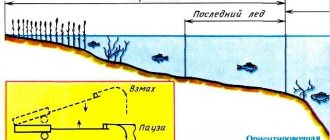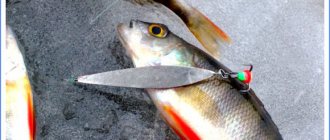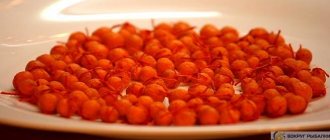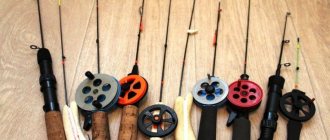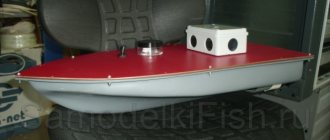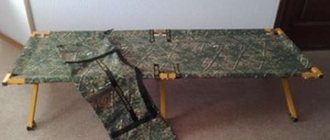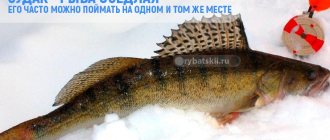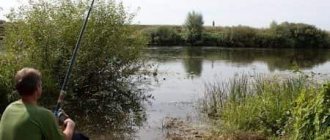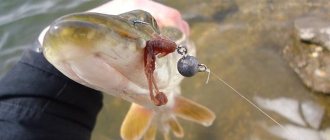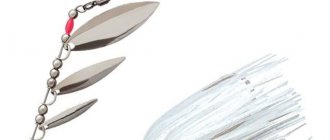DIY winter spinners: tips for making
Winter lures are among the most popular homemade products among ice fishing enthusiasts.
Among the baits there are real masterpieces that are superior in catchability to the most expensive branded analogues.
Our grandfathers and great-grandfathers successfully mastered the homemade production of spinners for ice fishing. Not being able to use metalworking machines and instruments, they made baits that regularly caught the predator. And in fact, it is not necessary to create computer models and then achieve the highest precision in manufacturing.
Even at home, you can come up with and implement a working spoon for winter fishing. It is only important to show resourcefulness and observation during production and subsequent testing. It is during the finishing process that it is possible to give an artificial fish those properties that a predator cannot resist.
The most popular baits among Russian winter fishermen are those for freshwater predators such as perch, pike and pike perch. Let's look at the main parameters of each type of winter lure, and also find out some of the secrets of catching bait.
How to catch pike with live bait?
In this case there are many features. Catching pike with live bait requires certain knowledge in this area. Today this method is not relevant. After all, spinners and twisters have almost completely eclipsed live bait. There are many of these devices. But don’t immediately forget live bait as bait. After all, it is he who is the real “parent” of artificial devices. It should also be taken into account that the pike is a predator that is not going to chase a shiny moving “thing” for a long time, but wants to catch prey.
Initially, in order for pike fishing with live bait to be successful, you should provide yourself with the necessary bait. In our case - fry. As a rule, the size of live bait corresponds to the size of the future catch. But it doesn't always happen like this. There are often cases when a small specimen is caught using bait of considerable size. Perhaps the fish's hunger is affecting it.
In order not to waste time, it is necessary to learn in more detail about the habitats of this predator. Also in this case, the equipment for fishing with live bait must be suitable.
Let's say a river is chosen as a fishing spot. In this case, fishing with live bait from the shore is quite possible. Since pike hunts not far from this place. What is this connected with? The answer is very simple - the fry does not have the habit of swimming to depths. Here we must immediately note an important condition. It lies in the fact that constant casting and maintaining depth is quite tiring. Thus, this action turns into a grueling process. Therefore, fishing with live bait on a float will be the best option for fishing for pike. This option will contribute to proper rest. Don't cast your fishing rod too far. It is better to find thickets of reeds for potential casting.
Homemade winter lure for perch
Perch is the most suitable predator on which you can train your skills when making homemade winter bait.
This fish is distributed almost everywhere, it is found in large rivers and reservoirs, small oxbow lakes and lakes. Only in shallow ponds, where there is no sufficient water exchange and there is a deficiency of oxygen, will you not find perch.
The most catchy winter baits for catching striped robbers are vertical spoons. Fishermen make their own models from different metals. It can be steel, copper, brass, cupronickel, silver. Let's consider the manufacture of a perch vertical using the example of a brass structure. The spoon is suitable for fishing in water areas up to 8 m deep; a characteristic feature of the bait is its stable action.
Step-by-step instruction
The sequence of actions looks like this:
- On a sheet of brass you need to draw a trapezoid 40 mm high, the upper base has a size of 6 mm, and the bottom has a size of 9 mm.
- Using metal scissors or a grinder with a cutting wheel, the marked workpiece is cut out.
- Sharp edges and burrs must be processed with a file or an emery wheel. The flat surface should be cleaned with fine abrasive sandpaper.
- The processed brass blank must be placed on a wooden or lead block, and then using a chisel or dowel and hammer to make a boat profile along the central axis.
- Tin-lead solder is poured into the resulting concave part of the workpiece. After drying and cooling, the surface is leveled with a knife and file.
- At each base of the trapezoid, a hole with a diameter of 1.5-2.0 mm is made using an electric drill and drill. After removing the burrs, winding rings are inserted into the holes.
- A triple hook is mounted to the wider base, which can be decorated with red cambric. You can make a red dot near the hook using a waterproof marker or paint.
The spoon is attached to the fishing line through a winding ring at a narrower base.
By changing the shape and size of the trapezoid, you can make a whole arsenal of perch lures. They are able to shoot when the fish ignores other baits.
Useful tips
In order to enjoy winter pike perch fishing, you need to listen to some tips:
- Do not use a balalaika fishing rod, as it is too soft to withstand such an aggressive, powerful predator as pike perch. In addition, its length will not be enough for a good hook.
- When leashes that are too long are used for a predator, it has the opportunity to spit out the bait and escape unscathed.
- At the same time, the behavior of the fisherman himself will also affect the effectiveness of the entire fishing. If you behave too loudly, stomp on the ice and talk loudly with your neighbors, he will definitely get scared and go to another, quieter place. Therefore, it is necessary to minimize all movements on ice.
- It is also advisable to get a small hook that will help you pull fish out of a narrow hole. At the same time, it will not fall down due to the fact that the hands are cold and the body of the fish is quite slippery.
- You should not use the same baits every day, even if they brought a good catch to the fisherman the day before. The fact is that this predator is diverse. Today he may prefer sprat, and the next day he will bite on the bulldozer. The fish behaves quite unpredictably, so experienced fishermen advise experimenting with a wide variety of baits to improve the bite, alternately dipping them into the ice hole.
- Use special maps to study the topography of a particular body of water. You should not miss this moment, since with its help you can note for yourself the presence of holes, edges, shallows, and flowing streams in a certain area. Studying the terrain will help you determine in advance the most promising places for fishing. What maps can be found on the Internet.
- Drill 3 to 5 holes at once and fish them. If the fish doesn’t bite, then move on to the next point.
Using these tips, winter fishing for pike perch can be made a very exciting activity, which also brings real catch.
If the material about fishing for pike perch in winter was useful, then share your opinion in the comments.
The post Fishing for pike perch in winter: all the details + video from the ice appeared first on Cool fishing.
Share on social media networks
0
Author of the publication
offline 3 hours
Pike spoon for winter fishing
To hunt for toothy predators, anglers make spinners of a different shape. They can be classified as oscillating baits. Spinner baits are quite difficult to manufacture, so a novice fisherman needs to be patient and hardworking.
Before starting work, you must prepare the following materials and tools:
- a piece of sheet metal (copper, brass, stainless steel);
- paints and varnishes;
- metal scissors or grinder;
- file and fine-grained sandpaper;
- electric drill;
- rubber mallet;
- vice and die;
- treble hooks and winding rings.
Manufacturing technology
The manufacturing technology includes the following steps:
- First, we select the shape of the spoon that is more suitable for fishing in a particular body of water. You can make a copy from a purchased fishing bait or draw a sketch in a fishing online forum.
- The outline of the future spinner should be transferred to a sheet of thick cardboard or whatman paper. If you have to make the same bait more than once, it is better to make the template on fiberboard. After this, a stencil of the workpiece is cut out with scissors or a jigsaw.
- Now the made template is placed on a metal sheet and the outline is outlined with a marker or a construction pencil. To cut out a metal workpiece, you should use special scissors or a grinder with a cutting wheel.
- It is necessary to remove burrs and sharp edges from the resulting figure. To do this, it is clamped in a vice and the surface is carefully processed with a file. You can immediately make holes for the winding rings.
- On the surface of the future spoon, you can imitate fish scales using a marker and a mallet.
- To give the workpiece the necessary bending lines, you will have to make a matrix. First, a cast is made from a working spoon in a plaster mash. After the plaster has dried, lead is poured into the resulting mold.
- When the matrix has cooled, all that remains is to remove the flash. You can start stamping the metal. The flat workpiece must be laid on the matrix and given the required profile using a mallet. There is no need to rush when deforming; the slightest inaccuracy in work can negatively affect the future parameters of the spinner.
- When the body of the pike bait is perfected, it is equipped with winding rings and a tee. After this, you can experience her playing in a deep and transparent container with water.
- The final manufacturing operation will be the color design of the artificial fish. When coloring, you can rely on your own knowledge or copy the appearance from the original.
- After applying the paint and drying, the product is coated with a waterproof varnish, which will increase the service life of the spoon.
Winter lures for pike
Spoons are the most effective means for those who decide to catch pike in the first ice, and one of the few that work in the dead of winter. In terms of catchability, they are in no way inferior to live bait, but are much more convenient for transportation and storage.
In addition, these baits, unlike supplies for passive fishing, will not let you get bored on the ice and will allow you to fully demonstrate your fishing skills. If we add to the listed advantages the ease of production at home, it becomes clear why winter spinners have many fans.
The game of a balancer in the water column
Externally, balancers can be divided into three types:
- Plastic feathers in the tail area.
- Tail fins made of feather or wool inserts.
- Silicone.
In a suspended state, on land, the front part of the balancer is slightly raised (the inclination does not exceed 5˚), but when it gets into the water, its balance is leveled, and the fish takes a horizontal position. As soon as the balancer reaches the desired depth, the game can begin . After a swing of the rod, the bait deviates far to the side and describes eights with a gradual slowdown in combinations. The quality of the product is determined by the amplitude of deviations and the speed of the game.
A characteristic feature of the balancer is that the lion's share of bites occurs when the bait freezes. These lures have long and short periods of play, after which the spoon freezes. The stage with a shorter duration lasts about 3-5 seconds and occurs after the balancer returns to its original position (to the center of the hole), then the fish begins to move around its own axis. The second stop occurs after 12-18 seconds.
Review of popular models
Pros:
- Easy to use and does not require special luster skills.
- Common spoon baits of this type are predominantly golden in color, appropriate in clear water;
- Good game at shallow depths.
Castmaster
Pros:
- Popular due to its effectiveness.
- A heavy spoon that has proven itself at great depths and strong currents.
- Wide distribution and low cost make the bait accessible to any angler.
- Huge selection of sizes and colors.
- Very often supplied with a shiny holographic sticker.
Pros:
- Time-tested model.
- Catchy with slow retrieve.
- Easy to make.
Pros:
- A believable game.
- Easy to use.
- Easy to make at home.
Pros:
- Original form.
- 2 types of game: small loop/movement from side to side with slight amplitude.
- It is possible for the hook to get caught on the fishing line when throwing the spoon.
Features of fishing with a balance beam
The easiest prey for a balancer, naturally, is perch. But if there are other predators in the reservoir, for example, pike perch or pike, they will definitely react to his game.
Of course, as when fishing with any bait, a balancer cannot guarantee a 100 percent catch, but it definitely has advantages over a spinner. In addition, this bait sometimes catches not just large, but even record-breaking specimens.
In addition to a huge number of advantages, the balancer also has some disadvantages:
- High cost compared to conventional spinners;
- More baits are lost on hooks;
- It takes longer to remove fish from hooks. This is very inconvenient when the bite is short-lived.
Catching large perch using a balance beam:
Choice for pike fishing
Properly selected bait is the key to success. In this matter, you should first of all focus on experience, and in its absence, make efforts to acquire it. It is useful to understand that pike preferences can vary depending on conditions and differ in different bodies of water.
It should be understood that this characteristic of the spinner, especially in winter, is one of the most important. Weight and size parameters are chosen based on ideas about the size of the future trophy, as well as conditions in its habitat, such as current and depth.
Small spoons are used if:
- Hunting for small fish is carried out.
- The fisherman is not afraid that in the intervals between pike bites, perch will be caught.
- A larger spoon does not bring results.
- It is known that pike is sluggish, capricious and cautious.
For example, during the so-called deaf winter, oxygen starvation makes itself felt. It makes the fish more passive and, when going out to hunt, the predator pursues a very small prey, which takes much less effort to catch.
Therefore, in such cases, the use of bait that imitates fry suggests itself and brings, albeit modest, but still trophies.
It makes sense to use large spoons when:
- You are only interested in large pike.
- Fish is active and not picky in its desire to fill its stomach.
Pike prefers wide baits. Their play in water is characterized by gliding with a large amplitude and the creation of a large number of vibrations. Narrow spoons cannot boast of this. And although they create the appearance of a wounded fish when waddling from side to side, they are primarily suitable for fishing for perch and pike perch.
Traditionally, spoons are made of metals and alloys. The most common ones are:
Silver and gold-plated baits occupy a special place. Their special attractiveness to fish is a controversial issue. But fishermen treat such spoons with special reverence - as if they were relics. They emphasize the status of the owner and cause considerable disappointment if broken or lost.
Sometimes baits are made from various types of metals. This has practical implications. The vibrations created as a result of the difference in electrochemical potentials will draw additional attention to your gear.
An integral part of almost every spinner is lead solder. It serves not only to impart the necessary load, but also creates a streamlined hydrodynamic shape.
Perhaps this is the most controversial and ambiguous parameter. On the one hand, the attention of a predator should be attracted by spinners colored in the colors of the fish included in its diet. Therefore, some lure lovers buy or make baits that resemble roach and ruff.
At the same time, bright lures of “flashy” colors have a good reputation. Other anglers only recognize spinners with metallic colors.
But there are still some universal tips:
- In muddy water the bait should be bright.
- At great depths and in cloudy weather it is better to use spinners of light colors, in sunny and shallow water - vice versa.
- representing a bleeding wound can bring success
- lures of metallic colors with a notch in the form of scales - in some cases this will make them more seductive.
- Holographic stickers add extra shine to baits and increase their visibility in clear water.
Fishing for perch in winter using lures
Catching perch with a spoon in winter is no different from fishing with a jig; both of these methods are on par in terms of the number of fish caught. If you are new to this business, then it is better for you to start fishing with a jig, since such tackle is much easier to set up and is also quite easy to play with.
But it’s not always better to choose the easy way; although it’s harder to catch with a lure, the catch will please you. This makes experienced fishermen want to impose on beginners that fishing with a spoon is still better. And every fisherman should know at least the basics of this type of fishing.
But not everything is as simple as it seems; one wrong movement of the bait can scare the fish. But you can eliminate the wrong game and understand what fishing with a spoon in winter is all about only after making many mistakes. You can only learn to fish with a spoon through experience.
Let's take a closer look at the advantages and disadvantages of spoons as bait for perch. Everyone knows that perch is a schooling fish. The moment of detecting a school of predator is key in the entire fishing process. And here a spoon comes to your aid, because only with its help can you quickly pull the fish out of the hole.
This type of gear usually uses a thick line, which will give you confidence during rhythmic fishing. The main thing is to choose the right ratio of the weight of the spinner and the thickness of the fishing line so that the bait quickly sinks under the water.
If you catch one perch, then you should immediately put the bait into the water, since the likelihood that you ran into a school is very high. The main thing is to do everything carefully so as not to scare away the fish. And you will never return home without a catch. And here is a small list of rules, following which you will catch fish:
- Try to spot a school of perch;
- Choose the right bait so that its play will definitely provoke the fish to bite;
- Make the spinner game as varied and natural as possible.
Now let’s take a closer look at the fishing technique, adhering to which you will not scare off the fish, but, on the contrary, will provoke it to bite:
- The first step is to adjust the working length of the fishing line. Then attach it to the rod. Then lower the spoon into the water so that it remains about 5 centimeters to the bottom. After which it is necessary to raise the bait, slowly accelerating its movement, and then lower it again. This wiring is considered classic and the easiest.
- The next type of fishing is fishing from the bottom. It is necessary to lower the bait to the bottom. Then, with a sharp swing of the rod, raise the bait half a meter from the bottom. Perch most often grabs the spoon with this type of fishing during the fall. If there are no fish near the bottom, then you can try fishing in this way in the middle and even in the upper layers of water.
- You can try to attract fish by rhythmically swinging the bait from bottom to top. Due to the fact that the bait quickly falls and rises, slack is formed on the fishing line, which leads to vibrations of the spoon. You can try to start this type of wiring with slow twitches, and then gradually move on to faster ones.
Sometimes you can see that the fish begins to get scared and the severity of the bites decreases with each perch. In this case, the fisherman simply needs to lift the school of fish into the upper layer of water. This is quite easy to do; you just need to reel in 10-20 centimeters of fishing line after each bite. Catching perch with a spoon in the upper layer of water is much easier.
How to choose the right winter lure for perch
When choosing a particular spinner model, you need to take into account a lot of factors, such as weather, features of the reservoir, and the like. It is believed that it is best to spy on what lure the locals are fishing for and find the same one for yourself. The experience of local fishermen has never failed. And since the spinner can only work under certain conditions, you can also watch how they play with it, maybe you’ll be able to learn some other secrets.
With your own hands
Most winter lures are made using the following technology:
- on a metal plate .
- Cut it out using metal scissors.
- The edges of the resulting workpiece are turned and polished.
- The back side of the plate is treated with solder acid and a layer of lead is applied using a soldering iron.
- Iron ears are soldered into the resulting lead layer to attach the spoon to the fishing line and the hook to the spoon.
- After this, the spoon is polished and given the correct streamlined shape.
- Sand the front side to give it an attractive shine.
- Winding rings are inserted into the ears.
- A tee with a bright cambric and/or red or orange edge placed on it is suspended from the lower ring
Blitz tips
- A catchable spinner on a pond is worth its weight in gold. Therefore, avoid the unpleasant surprise of a pike biting it off. Use a leash.
- A large supply of baits will allow you to experiment with size, color and shape and find the optimal solution in the specific conditions of a given reservoir.
- The stronger the current, the heavier the spoon should be.
- Most anglers consider the image of eyes on baits to be an unnecessary prop, but the predator uses them as a guide when aiming. In addition, such target points are applied to summer wobblers with some success. It is useful to do the same with winter bait.
- a tarnished lure using wool or felt. The use of abrasive pastes is acceptable.
- Monitor the condition of the hooks . Sharpen dull hooks. Replace rusty ones: the taste of oxidized metal is well captured by fish in the water and causes a decrease in the number of bites.
- Find out/determine the most effective retrieves for each spinner. Learn to do them.
How to catch perch with live bait?
There is nothing complicated here. Catching perch with live bait is quite simple and cheap. To do this, you don’t need to go to the store for expensive gear. Such as a spinning rod, an inertial reel, which costs a lot of money, wobblers, spinners, twisters. It is enough to choose a regular fishing rod, which is provided with fishing line and a simple reel. Harvesting live bait will also not take much time. You can use the previously described method of catching fry using a small fish. To do this, this device is immersed in water. Then bait is sprinkled on top (bread crumbs, grain, porridge). After some time, the little wren rises from the water with the already existing bait. A gudgeon, perch or other similar fry is quite suitable as bait for perch.
In this case, you should also be aware of the existence of three methods of placing live bait on a hook. That is, by the tail, by the back, by the lips. The latter is the safest for bait. It can be performed using either one or two lips. This placement of live bait provides it with the longest possible period of mobility. Despite its simplicity, this method has a huge disadvantage. It is with this method that the perch is able to easily tear the bait from the hook and leave.
You should be more careful when choosing to place the fry behind your back. Since as a result of this the ridge may be affected. Which will lead to the instant death of live bait.
Also in this case, it is worth paying attention to the process of casting the rod itself. It should happen smoothly. So that the live bait carefully enters the water and is not stunned as a result of hitting it or does not fall off the hook.
It is best to throw the rod into snags, as well as into areas overgrown with grass or reeds. If we talk about river fishing, then it is necessary to cast into an area of slow or reverse flow. The possibility of fish being in the shade close to the shore cannot be ruled out. This can especially work during hot times of the day. Therefore, in this case, fishing with live bait in the summer will be more acceptable.
